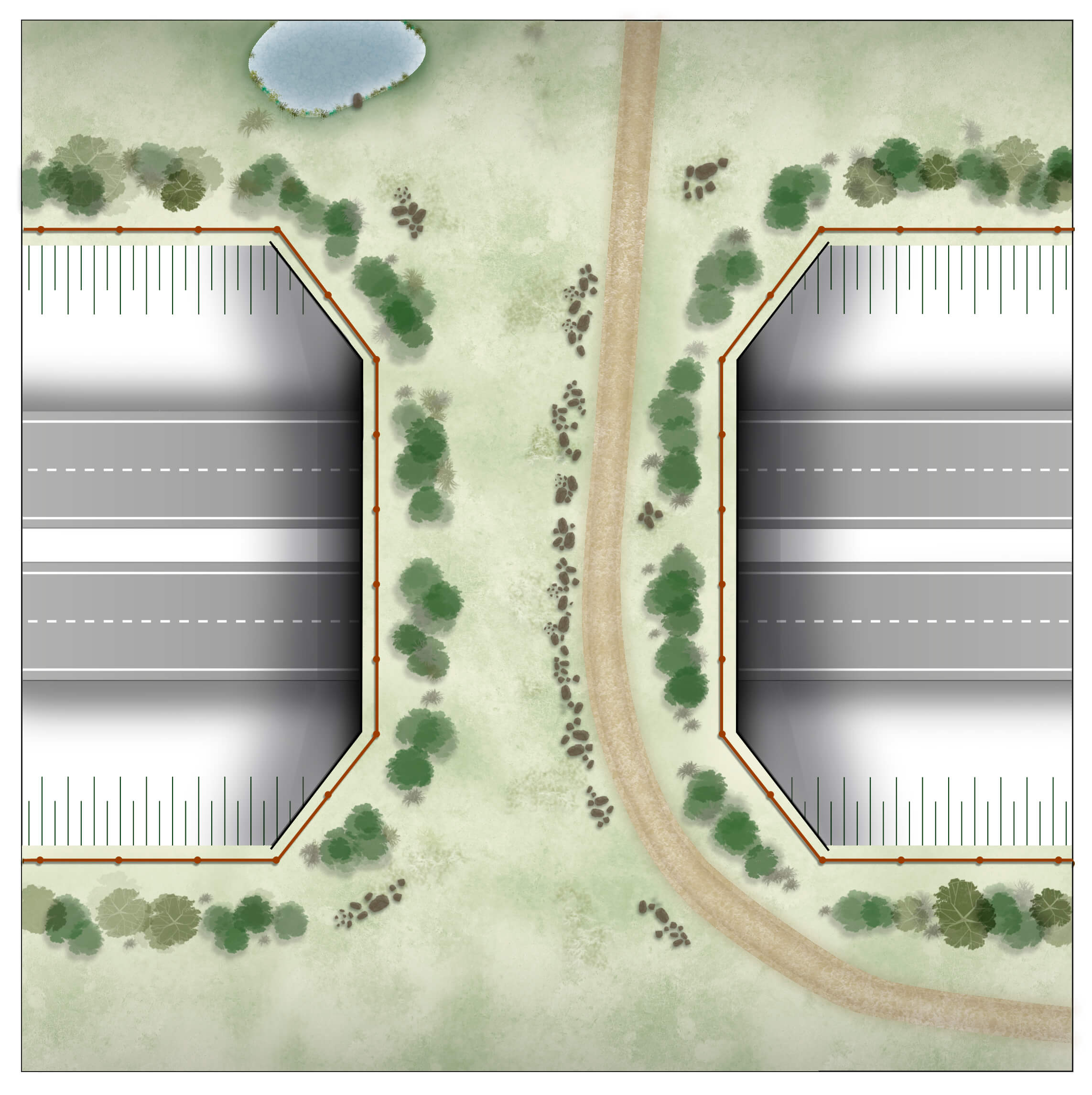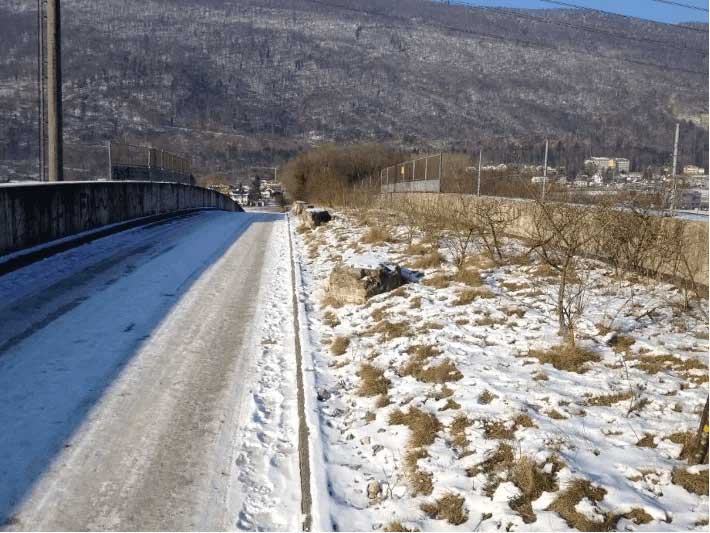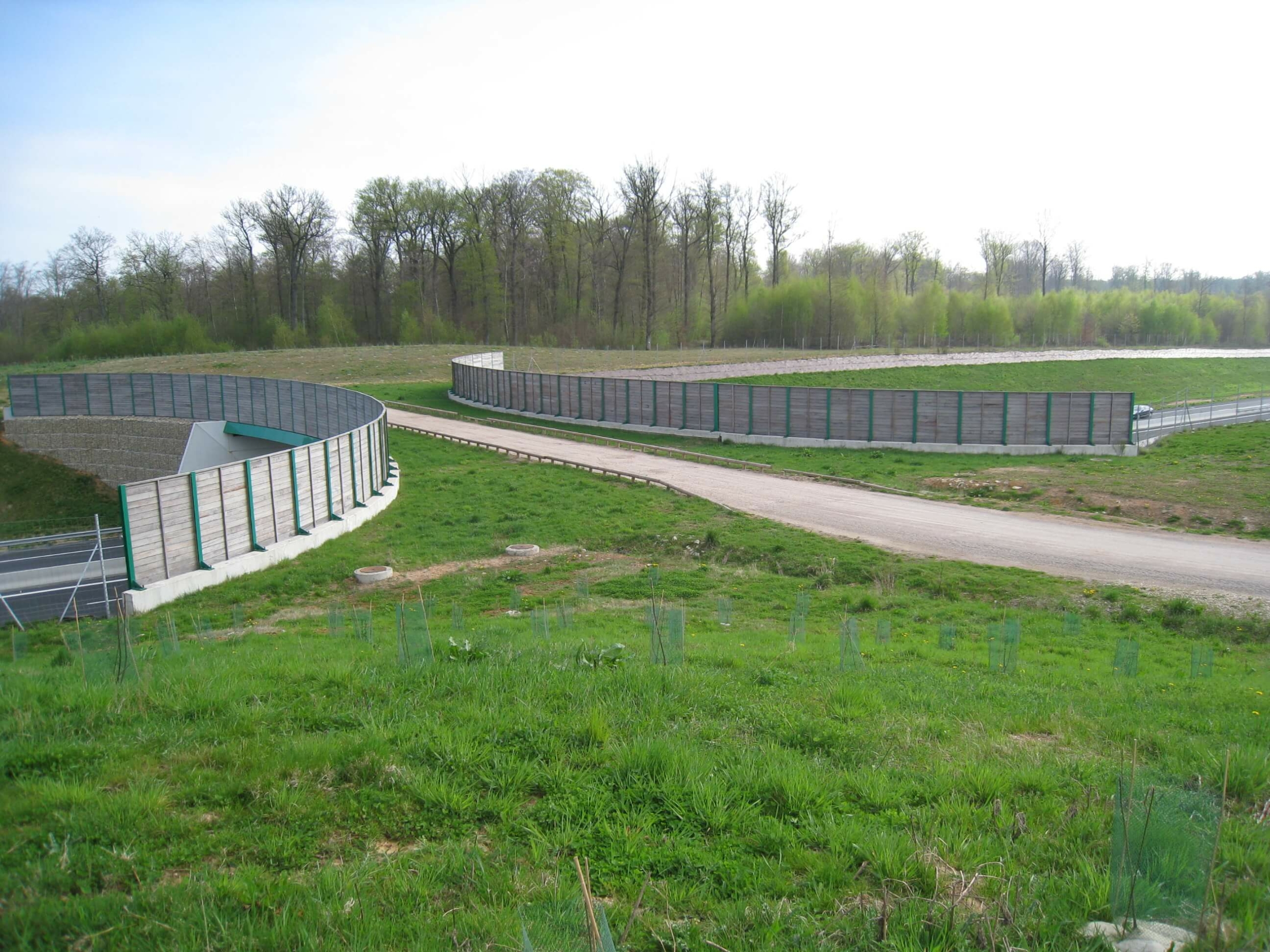General description and targets
Multiuse overpasses are structures built over linear transport infrastructure which combine human and wildlife use. In order to classify a passage as a ‘multiuse overpass’ it must meet the structural requirements of the target species, be located in a suitable and accessible environment and be provided with appropriate, specific maintenance to guarantee its long term functionality. Many of the features and requirements mentioned in Section 5.5.2 – Landscape overpasses and wildlife overpasses are also applicable to multiuse overpasses
Major linear transport infrastructures are typically crossed by many conventional overpasses for small forestry or agriculture roads, cattle passages or pedestrian paths. These structures are usually long and narrow, have paved tracks and are not designed for animals. However, such structures may be occasionally used by wildlife, and they may offer opportunities to be adapted to enhance this use by providing earthen strips with natural vegetation on both sides of the path or carriageway, screening to reduce disturbance from traffic and guiding fencing.
Due to their high numbers, they may contribute significantly to reducing the barrier effect of infrastructure on wildlife, but multiuse overpasses can never substitute for passages that are specifically designed for fauna and are free of human disturbance, having the potential to be used by a wider diversity of species.
Dimensions and landscaping determine the diversity of species that will use the structure. With joint use, particularly involving traffic, the potential for disturbance is higher, which could mean that species less tolerant of traffic noise and light will be deterred from using it.
When planning new infrastructure, any overpass located in a suitable area should be considered for adaptation to combine human uses with wildlife passage improving the global permeability of the infrastructure. Overpasses may all be equipped as standard with earth-covered strips, contributing greatly to mitigate the barrier effect at little additional cost. They must also be provided with appropriate landscaping, fencing and even made wider than required just for human use in all important areas for ecological connectivity. Cut-and-cover structures which are often built for aesthetic reasons to preserve the original aspect of the landscape or as a noise protection measure, can easily be adapted to be multiuse overpasses as well.
Existing overpasses may be retrofitted and upgraded to improve the permeability of infrastructure under operation The many pre-existing overpasses, if suitably adapted, could bring beneficial effects for ecological connectivity.
Design
- The recommended minimum width for multiuse overpasses in European standards ranges from 10 to 20 m (Table 5.3). A minimum of 10 m width may be sufficient when existing overpasses are being adapted to include wildlife use, with at least half of the section for natural soil and vegetation and the remainder for trails or small roads (Table 5.3). In passages located in important areas for ecological connectivity a minimum width of 20 m is recommended.
- Vegetation providing shelter near the entrances and leading to the passage, could improve its functionality for wildlife.
- Vegetated strips are recommended at both sides of any path or track on the overpass (Figure 5.5.19 and Figure 5.5.20). Strips of natural soil 1 to 2 m in width and allowing spontaneous vegetation growth could be enough to enhance movements of some target species particularly invertebrates or small vertebrates. Wider vegetated strips may facilitate the crossing of large mammals and also offer opportunities to provide refuges and habitats for small fauna i.e. rows of stones or wood. Rows of shrubbery may provide shelter and funnel bat flight.
- Measures to prevent the spread of invasive alien species (IAS) of plants should be applied. Seeding native species could prevent their growth.
- Soil cover must be adapted to the intended vegetation. A minimum depth of 0.3 m is enough to maintain grass and small shrubs.
- Screens to reduce noise and visual disturbance from traffic circulating under the structure must be installed on both sides of the overpass.
- Fencing to guide fauna to the entrances of the passage must be installed with fence ends appropriately connected to screens on both sides of the overpass. Design and specifications are given in detail in Section 5.2 – Fencing.
- Access for the animals onto the overpass must not be hindered by roads intersecting at the entrance (Figure 5.5.18).

Human co-use
- Adaptation of an overpass to enhance its use by wildlife is recommended only when traffic intensity is low; e.g. small roads with less than 500 vehicles per day, even if thresholds must be adapted considering local conditions. Unpaved dirt or gravel tracks are preferred as such surfaces may allow the movements of both small and large wildlife. A ban on vehicle circulation, temporary road closure or limited access to certain vehicle types (e.g., tractors, bicycles) are additional options to be considered.
- On large overpasses, tracks for vehicles must run along one of the outer edges of the structure to ensure a maximum width of vegetated and undisturbed area. Screens or earthen walls to separate the track and the vegetated area are not recommended in general, but could be included on large structures to reduce disturbance if traffic intensity is over 500 vehicles per day.
- Overpasses modified to enhance wildlife should be kept dark at night, avoiding artificial lighting.
- Information panels about wildlife use of the passage could be provided to promote an appropriate use by people and to reduce human disturbances.
- Access for people at night or during certain seasons critical to wildlife movements could be restricted.
- Where conflicts between human and animal use arise and the passage is in a critical location for ecological connectivity, the provision of a separate passage for pedestrians or vehicles is recommended.

